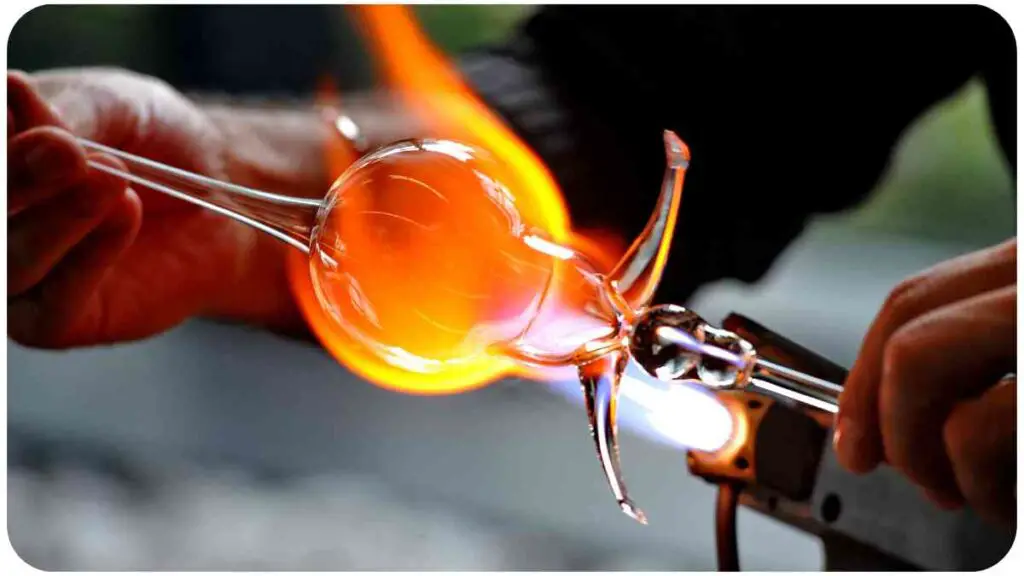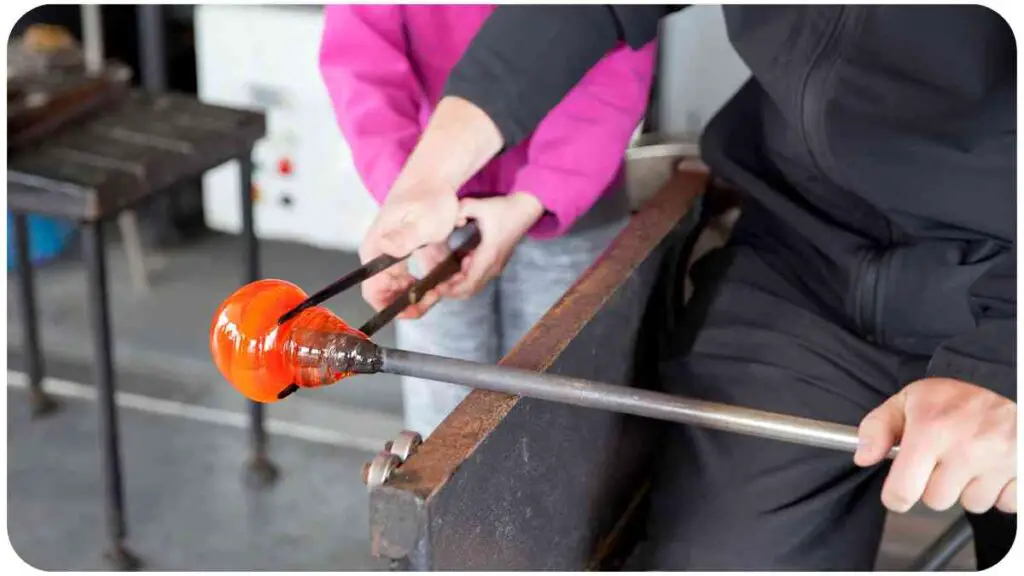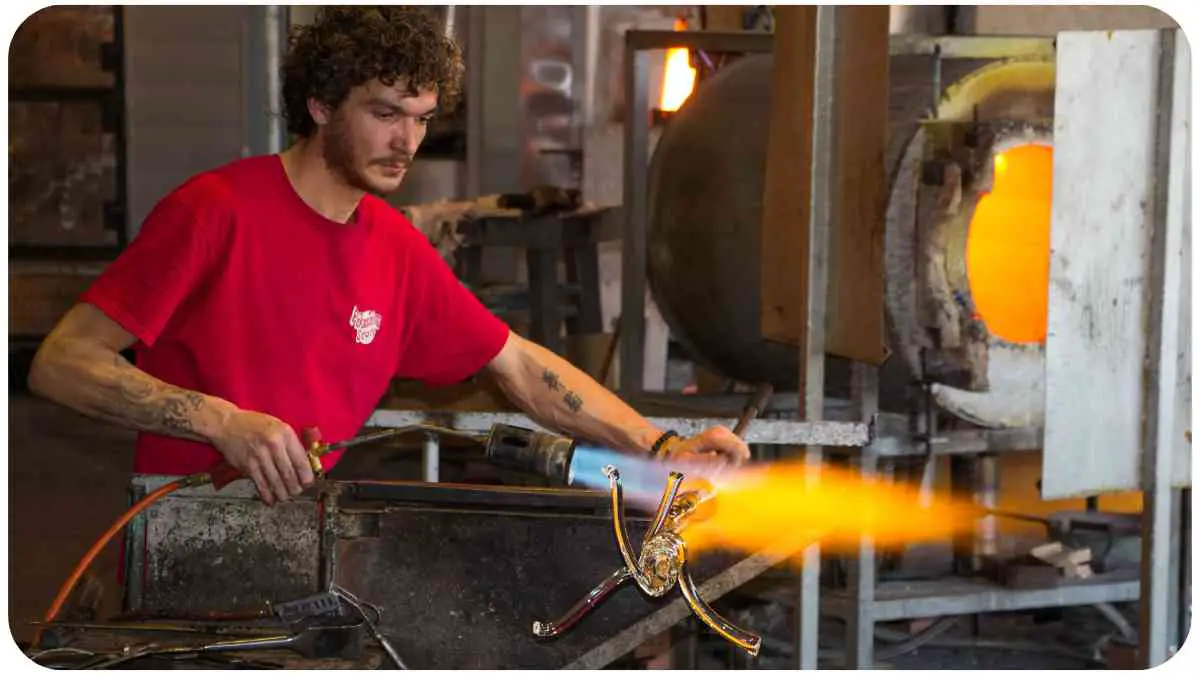Glass blowing is a captivating art form that requires precision and creativity. However, amidst the mesmerizing dance of molten glass, safety must always take center stage.
In this guide, we’ll delve into the crucial aspects of glass blowing safety, providing insights, tips, and real-world examples to ensure a secure and enjoyable experience.
| Takeaways |
|---|
| 1. Understanding Risks: Recognize the inherent dangers in glass blowing, such as high temperatures and sharp tools. |
| 2. Essential Safety Equipment: Invest in protective clothing, ventilation systems, eye protection, first aid kits, and emergency shutdown procedures. |
| 3. Workspace Organization: Maintain a well-organized workspace layout and implement fire safety measures. |
| 4. Glass Types and Safety: Handle different glass materials with care, considering their unique characteristics and temperature control. |
| 5. Training and Education: Prioritize formal training programs and continuous learning to enhance safety awareness. |
| 6. Common Mistakes to Avoid: Steer clear of neglecting safety guidelines, rushing the process, and lacking proper planning. |
| 7. Case Studies: Learn from experts who have successfully implemented safety practices in their studios. |
| 8. Regulatory Compliance: Adhere to industry standards, OSHA regulations, and ASTM International standards. |
| 9. Emergency Preparedness: Conduct fire drills, establish evacuation plans, and be prepared to handle accidents. |
| 10. Creating a Safety Culture: Involve the entire team, conduct regular safety meetings, and prioritize a culture of safety. |
| 11. Balancing Productivity and Safety: Develop efficient workflows, delegate tasks wisely, and prioritize safety without compromising results. |
| 12. Innovations in Safety: Stay updated on advancements in safety equipment and embrace technological solutions. |
| 13. Conclusion: Safety is paramount for the well-being of artists and the success of the studio. Foster a culture of safety to thrive creatively. |
| 14. Additional Resources: Explore OSHA standards, ASTM International glass standards, and the Glass Art Society for more information. |
Importance of Safety in Glass Blowing

2.1 Understanding the Risks
Glass blowing involves working with high temperatures, sharp tools, and delicate materials. Understanding the inherent risks is the first step towards creating a safe working environment.
Delve into the mesmerizing world of glass art with this comprehensive guide. Learn about the evolution of sculptural styles, from ancient classics to modern masterpieces. Discover the endless possibilities of this timeless craft
| Risks | Safety Measures |
|---|---|
| High Temperatures | Proper insulation and temperature control |
| Sharp Tools | Use of protective gloves and handling tools with care |
| Delicate Materials | Gentle handling techniques and proper storage |
2.2 Common Accidents in Glass Blowing
To address safety concerns effectively, let’s explore some common accidents in glass blowing and how they can be prevented.
| Accidents | Prevention Measures |
|---|---|
| Burns from Hot Glass | Adequate protective clothing and awareness of hot zones |
| Cuts from Sharp Tools | Regular tool maintenance and cautious handling |
| Inhalation of Fumes | Ventilation systems and the use of respiratory protection |
Essential Safety Equipment
3.1 Protective Clothing
Wearing the right protective clothing is non-negotiable in glass blowing. The table below outlines the essential items for ensuring personal safety.
| Protective Gear | Purpose |
|---|---|
| Heat-Resistant Apron | Shielding the body from heat and molten glass |
| Kevlar Gloves | Protection against cuts and burns from hot glass |
| Face Shield | Safeguarding the face and eyes from splashes |
| Closed-toe Shoes | Preventing injuries from falling objects or hot glass |
3.2 Ventilation Systems
Proper ventilation is crucial to disperse fumes and ensure a healthy workspace. Consider the following factors for an effective ventilation system.
| Ventilation Factors | Safety Implications |
|---|---|
| Airflow Direction | Directing fumes away from the workspace |
| Filtration Systems | Filtering out harmful particles and gases |
| Regular Maintenance | Ensuring the system is in optimal condition |
3.3 Eye Protection
The eyes are particularly vulnerable in glass blowing due to the potential for splashes and flying debris. Here’s a breakdown of eye protection measures.
Crafting stunning sculptures doesn’t have to break the bank. Explore the art of budget-friendly sculpture with basic tools. Unleash your creativity without compromising on quality or artistic expression.
| Eye Protection Measures | Importance |
|---|---|
| Safety Glasses | Shielding the eyes from direct impact |
| Goggles | Providing a seal to prevent debris entry |
| Emergency Eyewash | Immediate response in case of eye exposure |
3.4 First Aid Kit
Accidents can happen, so it’s essential to have a well-equipped first aid kit readily available. Ensure your kit includes:
| First Aid Supplies | Usage |
|---|---|
| Burn Ointment | Immediate treatment for burns |
| Bandages | Wound care and protection |
| Pain Relievers | Managing pain from minor injuries |
3.5 Emergency Shutdown Procedures
Having clear emergency shutdown procedures in place is vital for swift action in critical situations. Train your team on the steps to follow in case of emergencies, such as power failures or equipment malfunctions.
Workspace Organization

4.1 Proper Layout
The organization of your workspace significantly contributes to safety. Consider the following table for effective workspace organization.
Master the art of watercolor painting by understanding the variety of paper choices. Explore a comprehensive guide that delves into the impact of paper on your watercolor artworks. Elevate your creations with informed choices.
| Workspace Organization | Safety Tips |
|---|---|
| Clear Pathways | Avoiding trip hazards and facilitating easy movement |
| Tool Storage | Keeping tools organized and easily accessible |
| Emergency Exits | Ensuring quick and unobstructed exits in case of emergencies |
4.2 Fire Safety Measures
Fires can pose a severe threat in a glass blowing studio. Implement the following fire safety measures to reduce the risk.
| Fire Safety Measures | Preventive Actions |
|---|---|
| Fire Extinguishers | Having accessible and regularly checked extinguishers |
| Flame-Resistant Materials | Using materials that resist catching fire |
| Emergency Response Plan | Training employees on evacuation procedures |
Glass Types and Safety Considerations
5.1 Handling Different Glass Materials
The type of glass used in blowing varies, each with unique characteristics. Understanding how to handle different glass materials is crucial for safety.
| Glass Type | Safety Considerations |
|---|---|
| Borosilicate Glass | Resistant to thermal shock, handle with care to prevent breakage |
| Soft Glass | Lower melting point, requires careful temperature control |
| Fused Silica | High resistance to heat, but can be brittle, handle gently |
5.2 Temperature Control
Maintaining precise temperature control is fundamental in glass blowing. The table below outlines safety considerations for temperature management.
Jewelry crafting is a rewarding pursuit, but even the best pieces can face issues. Learn how to fix a broken clasp with ease. Keep your handmade jewelry intact and ready to adorn.
| Temperature Control | Safety Guidelines |
|---|---|
| Annealing Process | Gradual cooling to prevent stress and fractures in the glass |
| Molten Glass Handling | Use proper tools and techniques to avoid burns and spills |
| Cooling Time | Allow adequate cooling time to avoid handling hot glass |
Training and Education
6.1 Formal Training Programs
Proper training is the cornerstone of safety in glass blowing. Investing in formal training programs ensures that artists are equipped with the knowledge and skills to navigate potential hazards.
| Training Programs | Benefits |
|---|---|
| Glass Blowing Workshops | Hands-on experience and guidance from experienced instructors |
| Safety Certification | Recognition of adherence to safety standards |
6.2 Continuous Learning
Safety is an ongoing commitment. Encourage continuous learning and stay updated on the latest safety protocols through workshops, seminars, and industry publications.
| Continuous Learning | Advantages |
|---|---|
| Skill Refinement | Improving techniques for safer practices |
| Awareness of Innovations | Staying informed about new safety equipment |
Common Mistakes to Avoid

7.1 Ignoring Safety Guidelines
In the excitement of creating beautiful glass art, it’s easy to overlook safety guidelines. However, adherence to these guidelines is crucial to prevent accidents.
Ensure the longevity of your artistic creations with a comprehensive guide. Explore techniques and tips for preserving various art forms, safeguarding your masterpieces for years to come.
| Common Mistake | Consequences |
|---|---|
| Neglecting Safety Gear | Increased risk of burns and injuries |
| Skipping Ventilation | Exposure to harmful fumes and toxins |
7.2 Rushing the Process
Glass blowing is an art that requires patience. Rushing the process can compromise safety measures.
| Common Mistake | Safety Implications |
|---|---|
| Overheating Glass | Increased risk of burns and glass breakage |
| Hasty Tool Usage | Greater likelihood of accidents |
7.3 Lack of Proper Planning
Proper planning is the foundation of a safe glass blowing environment. Neglecting planning can lead to chaotic and potentially dangerous situations.
| Common Mistake | Safety Consequences |
|---|---|
| Inadequate Workspace Setup | Increased risk of accidents and injuries |
| Lack of Emergency Procedures | Delayed response in critical situations |
Case Studies: Safety Success Stories
8.1 Overcoming Safety Challenges
Learning from the experiences of seasoned glass blowers can provide valuable insights into effective safety practices. Let’s explore a case study of an expert who successfully navigated safety challenges.
| Expert’s Journey | Key Takeaways |
|---|---|
| Initial Safety Struggles | Recognizing the importance of safety after facing near-miss incidents |
| Implementation of Safety Measures | Investing in quality protective gear and establishing strict safety protocols |
| Positive Outcomes | Reduced accidents, increased productivity, and a healthier work environment |
8.2 Implementing Effective Safety Practices
Another expert in the field shares their journey towards creating a safer workspace.
| Safety Initiatives | Impact on Studio Safety |
|---|---|
| Employee Training Programs | Improved awareness and adherence to safety guidelines |
| Regular Safety Audits | Identified and addressed potential hazards proactively |
| Community Engagement | Encouraged a culture of safety beyond the studio |
Regulatory Compliance
9.1 Understanding Industry Standards
Adhering to industry standards is not just a legal requirement but a crucial aspect of ensuring safety in glass blowing.
| Industry Standards | Importance |
|---|---|
| OSHA Regulations | Legal compliance and workplace safety |
| ASTM International Standards | Ensuring the quality and safety of materials |
9.2 Compliance Checks and Audits
Regular compliance checks and audits are essential to identify areas of improvement and ensure that safety measures are consistently upheld.
| Compliance Measures | Frequency |
|---|---|
| Internal Safety Audits | Conducted quarterly to assess safety protocols |
| External Regulatory Checks | Annually to meet legal requirements and industry standards |
Emergency Preparedness
10.1 Fire Drills
Conducting regular fire drills is a simple yet effective way to prepare everyone in the studio for emergencies.
| Fire Drill Practices | Benefits |
|---|---|
| Clear Evacuation Routes | Ensures a quick and orderly evacuation |
| Familiarity with Fire Extinguishers | Promotes effective response in case of a fire |
10.2 Evacuation Plans
Having well-defined evacuation plans is crucial for ensuring the safety of everyone in the studio during emergencies.
| Evacuation Plan Components | Importance |
|---|---|
| Emergency Exits | Clearly marked and easily accessible |
| Assembly Points | Designated areas for a headcount after evacuation |
10.3 Dealing with Accidents
Despite all precautions, accidents can still occur. Being prepared to handle accidents is as important as preventing them.
| Accident Response | Steps to Take |
|---|---|
| Immediate First Aid | Administer first aid while awaiting professional medical help |
| Reporting Procedures | Documenting incidents for analysis and improvement |
Creating a Safety Culture
11.1 Team Involvement
Fostering a safety culture requires the active participation of everyone in the studio. The table below highlights strategies for involving the entire team.
| Team Involvement Strategies | Impact on Safety Culture |
|---|---|
| Regular Safety Meetings | Open communication and awareness of safety concerns |
| Employee Feedback Systems | Encouraging input on safety improvements |
| Recognition Programs | Acknowledging and rewarding safe practices |
11.2 Regular Safety Meetings
Conducting regular safety meetings is a cornerstone of maintaining a safety-conscious environment.
| Meeting Topics | Importance |
|---|---|
| Incident Reviews | Learning from past events to prevent recurrence |
| Safety Protocol Updates | Keeping the team informed about any changes in safety guidelines |
Balancing Productivity and Safety
12.1 Efficient Workflows
Balancing productivity and safety requires streamlined workflows. The following table outlines key considerations for achieving this balance.
| Efficient Workflows | Safety Measures |
|---|---|
| Time Management | Allocating sufficient time for each step of the process |
| Task Delegation | Distributing tasks according to individual skill levels and safety training |
12.2 Prioritizing Safety without Compromising Results
It’s possible to achieve high-quality results without compromising safety. Prioritizing safety contributes to long-term success.
| Balancing Safety and Results | Achieving Both |
|---|---|
| Skill Development | Investing in continuous training to enhance both safety and proficiency |
| Quality Control Measures | Implementing checks to ensure the final product meets standards |
Innovations in Glass Blowing Safety
13.1 Advancements in Safety Equipment
Keeping abreast of technological advancements is crucial for enhancing safety in the studio.
| Safety Equipment Innovations | Impact on Safety |
|---|---|
| Advanced Respirators | Improved protection against harmful fumes |
| Smart Temperature Monitoring | Real-time monitoring for precise temperature control |
13.2 Technological Solutions
Utilizing technology can significantly contribute to a safer working environment.
| Technological Solutions | Safety Enhancements |
|---|---|
| Automated Emergency Systems | Swift response in case of accidents or equipment failures |
| Virtual Reality Training | Immersive training experiences for better retention of safety protocols |
Conclusion
In conclusion, maintaining safety in glass blowing is paramount for the well-being of artists and the success of the studio. By understanding the risks, implementing proper safety measures, and fostering a culture of safety, the glass blowing community can continue to thrive while ensuring a secure and enjoyable creative process.

Hellen James is the creator of Unified Crafts and has been crafting since she was a kid accompanied by her mom to the craft store, where she was free to choose whatever ignited her imagination.

